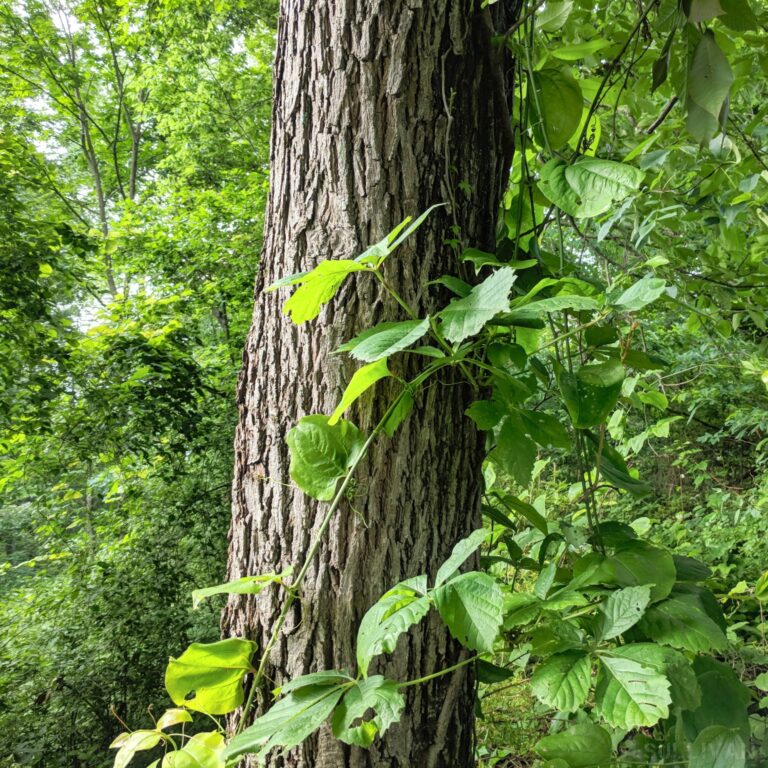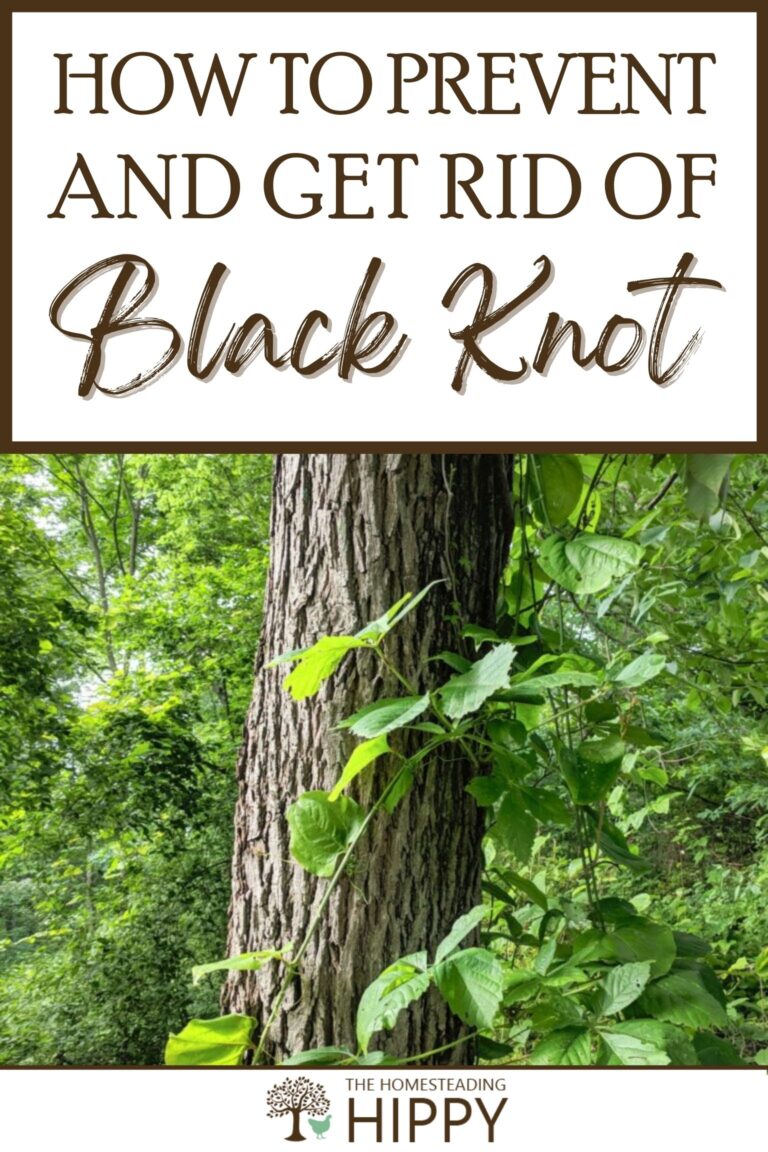Black knot is a plant disease that sounds just as ominous as it actually is. Fortunately, it is easy to treat and prevent.

Growing fruit trees is something that I have yet to get into on my small farm, but it’s a plan I have for the future.
As I build my experience and plan the trees I want to grow, I’ve heard from many other local gardeners and farmers about the dangers of black knot for plum and cherry trees in particular.
This pernicious fungal disease can not only ruin the production of your fruit trees, but it can make them look less than attractive, too – a major hindrance if you’re growing these trees for their ornamental value.
Luckily, there are several steps you can take to avoid it. Here’s how to prevent and get rid of black knots.
Table of Contents
What is Black Knot?
Black knot is a nasty fungal disease that is caused by a fungus named Apiosporina morbosa.
This fungus can dramatically reduce the production of fruit trees and it can decimate their overall appearance. It is common on about 25 species of plants in the Prunus family.
It spreads much like other fungal diseases do – in wet weather. In this spring, the fungus generates infectious spores that are ejected during particularly rainy periods.
As the rain comes down, it splashes the spores and blows them in the wind to susceptible plant parts.
These spores can then infect new tissues in as little as six hours. Usually, the primary time of infection is sometime between April and June, when it’s somewhat warm and particularly wet.
It generally needs to be about 60 degrees for the disease to proliferate.
Unfortunately, the problem does not go away from year to year, either. The fungus can overwinter in the stem of the infected host and will start growing again come spring.
These spores can continue to be produced and reinfect the same tree or move on to new trees as well. The only thing that ultimately stops black knot from spreading, sadly, is if the knot girdles the stem and kills it.
Some of the most common trees affected by black knot fungus are plum and cherry trees in North America. It’s been reported on the following species along with all of their relative cultivars:
- American plum
- Japanese plum
- European plum
- Mahaleb cherry
- Sweet cherry
- Both cultivated and wild chokecherries
There is some evidence that black knot can affect other kinds of stone fruit, too, like peaches and apricots.
What Are the Symptoms of Black Knot?
Black knot presents several telltale signs. The most obvious is easy to remember, since it has to do with the name of the disease – the black knot!
An infected plant will develop large, hard, and black knots that are usually around one to six inches in length.
These knots can be found anywhere on the tree, usually growing in size and number during successive years if the disease is not treated.
When the symptoms first appear, you might see the knots more as benign swellings on the shoots that developed in that current season.
However, the following spring, you’ll likely find that the bark is splitting and the knots have become corky and green – later hardening and blackening by the end of that year.
If a twig is sick, it will often bend to one side, wilt, fail to leaf out, and then ultimately die.
People who have struggled with black knots on their trees often report that it looks a lot like coal bunching up on the tree.
Unfortunately, it can be hard to know right away that your tree has been infected because it can take years for the fungus to appear – a tree can appear healthy for quite some time, even while the fungus is growing rapidly.
By the time you notice black knots on the tree, it’s often too late.
How to Prevent Black Knot
Practice Good Hygiene and Pruning Practices
Practicing good hygiene in the orchard or garden is your first step at eliminating and preventing black knot.
Make sure your trees are pruned regularly so that there is adequate airflow between the branches.
This will not only help you prevent this particular kind of fungus, but it can help you get rid of a long list of other fungal diseases, too.
When to prune, though, make sure you take the time to thoroughly sanitize your equipment.
That way, if there are any fungal problems present on your plants, you won’t have to worry about spreading the issue to the next plant that you cut.
Use a sanitizing solution that contains at least 70% rubbing alcohol. This can prevent reinfection.
Remove Wild Hosts
There are some naturally occurring plants that are considered wild hosts of the disease.
They aren’t quite as susceptible to black knot’s many threats yet can easily spread these pores to more vulnerable commercial trees.
If you can’t get rid of wild hosts on your property, plant new trees that are upwind from wild trees.
Instead, plant-resistant varieties of plants – for example, there are several resistant plum varieties that hold up well against black knot, including Damson, Santa Rosa, and Bradshaw.
For whatever reason, it is believed that tart cherry varieties are less susceptible to the virus than sweet, and that Japanese plums might be somewhat less susceptible than American varieties. Check with your local nursery to see what they recommend.
Use a Preventative Spray
If you’ve struggled with black knot in the past – or you know it’s something that growers in your area have issues with – you may just want to bite the bullet and apply a preventative spray ahead of time.
This is a good idea if you can’t figure out where the disease is coming from or if you are trying to bring a tree that was heavily infected back to health.
You can use a spray of lime sulfur (applied during the dormant period) when you prune trees. You can also use a fungicide that’s listed specifically for black knot.
This could be applied at bud break as well as every week until the end of the growing season.
Practice Proper Spacing
Make sure your trees are spaced far enough apart when you plant.
Exactly how far you should space out your trees will vary depending on what kind of tree you are growing, but make sure you follow all recommended guidelines.
The more airflow, the better – this will make it harder for the fungus to spread.
How to Get Rid of Black Knot
Prune and Dispose of Cuttings
The First thing you need to do if you find black knot on your tree is to prune it. You will want to remove all knots and swollen areas, pruning at least three inches below the knot.
This should ideally be done during the tree’s dormant season and before the start of rainy weather in April.
If you notice infections on larger branches, you will need to cut the tissue all the way down to healthy wood.
Make sure you use sterile pruning shears to cut your branches and then burn or bury prunings. Do not attempt to compost them and make sure you get them out of the area.
Even when the branches and pieces are no longer attached to the tree, they can still contain spores that will spread to nearby plant parts.
Cut Severely Infected Trees
As much as it may pain you to do this, if you have a large-scale black knot infestation, you may just need to cut the tree. Remove all parts from the vicinity.
You won’t be able to resolve the infestation, and getting rid of the tree might be the only way to stop it from spreading to nearby trees.
Use Neem Oil
Some people swear by using neem oil on their trees. This natural fungicide won’t usually harm pollinators and is safe for use on edible crops.
It unfortunately will not kill fungus that is already present but can stop its spread. It’s also effective for other kinds of fungal diseases, such as rust, leaf spot, and scab.
You will need to apply the spray about once per week until the weather gets dry, usually spraying just before leaves and blossoms emerge.
Monitor Trees Carefully
It can be difficult for you to detect the initial signs of black knot fungus infestation, so it’s important that you monitor the tree carefully.
Keep an eye on your tree as well as nearby trees for new signs of infestation, at least for the next few months and years.
Consider Contacting a Tree Care Expert for Help
If your problems with black knot are extremely pronounced, you may have to call in the big guns.
Sometimes, this disease becomes far too advanced for the “average Joe” to deal with on his or her own.
That’s especially true if you need to cut your tree and don’t have much experience with tree cutting.
You may want to get in touch with a tree care professional who can either guide you through the steps or remove the black knot fungus (or diseased tree) for you.
Black knot fungus can be an incredibly frustrating disease to deal with, especially when you consider that it is often chronic and can kill your trees entirely.
However, by following good preventive measures and doing everything you can to keep your trees healthy, it’s a disease that you should be able to more or less keep at bay.


Rebekah is a full-time homesteader. On her 22 acres, she raises chickens, sheep, and bees, not to mention she grows a wide variety of veggies. She has a huge greenhouse and does lots of DIY projects with her husband in her ever-growing homesteading endeavor. Learn more about Rebekah here.
